Flying/Sporting Pigeon: History, Overview And More
Flying, also known as Sporting pigeons, are domesticated pigeons renowned for their flying and acrobatic abilities.
One popular belief is that homing and sporting pigeons are the same. They aren’t.
Homing pigeons are good at flying long distances and returning home. While Sporting pigeon breeds can roll, fly high, and exhibit heavy endurance. These skills, however, vary from breed to breed.
Pigeons have been a part of humans’ lives for a long time. They served various purposes, from providing meat to sending messages, from being a pet and source of entertainment to being a deity!
People were fascinated by the unique traits of pigeons, so they experimented with pigeons, leading to the birth of many flying pigeon breeds.
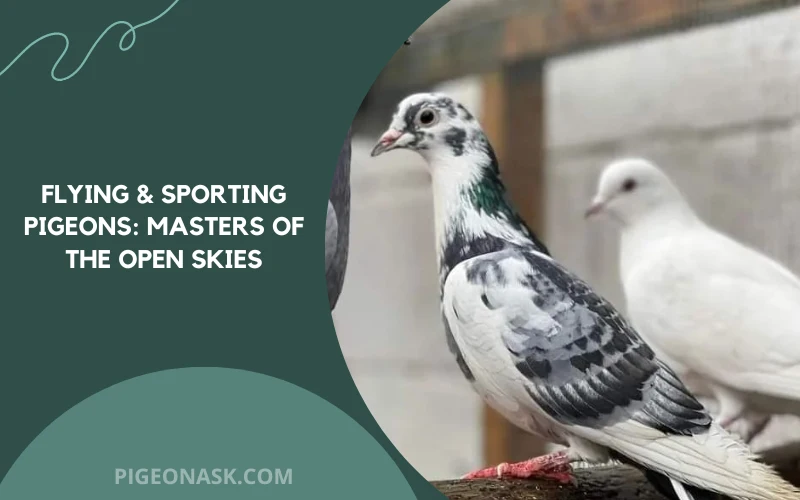
For convenience, pigeon fanciers arbitrarily grouped domesticated pigeons into three categories, and flying/sporting pigeons are one of them. The other two are Fancy and Utility pigeons.
Even though Flying/Sporting pigeons belong to a separate group altogether, these are technically fancy pigeons and are known as such among general people.
General Profile of Flying/Sporting Pigeons
| Characteristics | Flying/Sporting Pigeons |
|---|---|
| Common Names: | Flying Homer, Racing Homer, Carrier Pigeon, Tumbler Pigeon |
| Origin: | Columba livia (City Dove) |
| Size: | 9 to 13 inches (23 to 33 cm) |
| Weight: | 340 to 450 gm |
| Lifespan: | Up to 20 years |
| Physical Features: | Shades of gray, white, black color and aerial acrobatics |
| Temperament: | Social, Territorial, Calm, Industrious |
| Breeding and Maintenance: | Low-cost and low maintenance |
| Common or Popular Varieties: | Chistopolian Highflyer, Birmingham Roller, Skycutter, Serbian HighFlying |
Looking for more articles about pigeon type:
A Short Overview of the Flying/Sporting Pigeons
Flying pigeons are some popular breeds of domesticated pigeons. Both the wild and domestic pigeons came from a single species called the rock dove (Columba Livia).
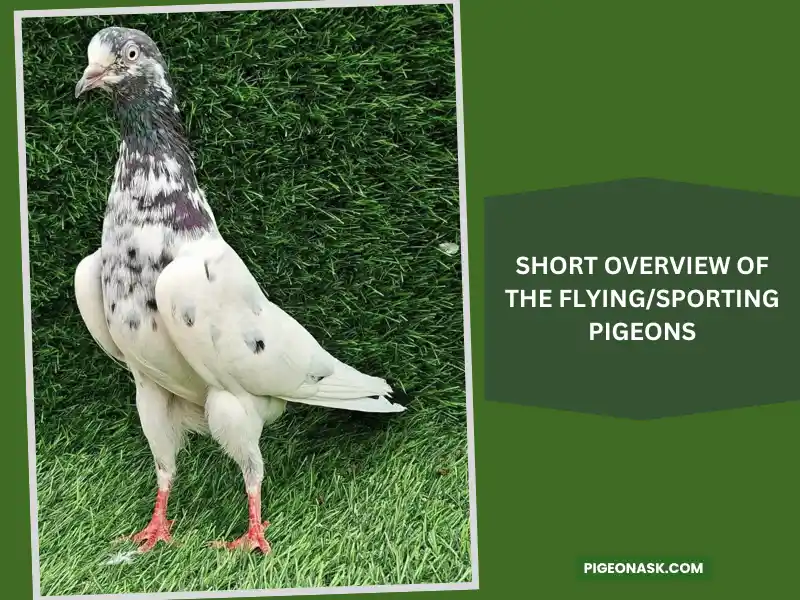
Flying/Sporting pigeons were bred for their flying abilities and heavy endurance.
They are good in the air, possessing both acrobatic and aerobatic skills. However, it’s important to note that some flying pigeons don’t show acrobatic skills due to crossbreeding or staying in captivity for a long time.
Sporting pigeons grouping contains four categories –
- Rollers and tumblers
- Tipplers
- Highflyers
- And Racing
Some experts, however, prefer putting Racing pigeons in a separate group.
Rollers and tumblers have in-flight skills. They can, as their names suggest, tumble and roll. As for the Tipplers, they can fly high and have the best endurance.
This breed has a record of flying for 20 hours straight. Moreover, Tipplers can fly high but not as high as Highflyers. Highflyers can reach a very high altitude, holding a record of 2000 meters.
Flying pigeons’ distinctive capabilities are a source of amusement to people. Owners participate in shows and competitions with their pigeons, especially Rollers and Tumblers. Pigeon lovers rarely miss those shows.
Flying/Sporting pigeons are easy to care for, and that too at a cheap rate. You just need to build them a home and feed them whatever you can, they will usually manage their own food.
Additionally, you let them fly for a specific time each day, buy medicines when they get sick, and you’re good to go.
History of Flying/Sporting Pigeons
Pigeon domestication likely began in the Middle East and was practiced by ancient civilizations such as the Egyptians, Greeks, and Romans.
For an extended period in history, flying pigeons served as the primary means of long-distance communication.
Although humans and pigeons go way back in history, breeding specialized pigeons for racing, rolling, and tumbling purposes has become popular comparatively recently.
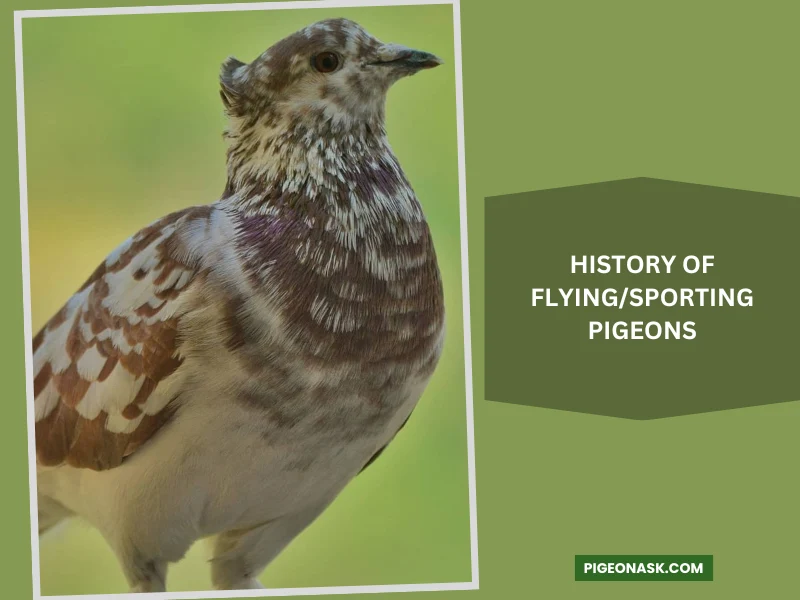
The existence of pigeon racing as a sport can be traced back to 220 AD in history.
In the modern world, the first pigeon race took place in Belgium back in 1818. This race involved an impressively long track of over 100 miles or 160 km.
In later years, the popularity of this sport rose across different countries in Europe.
So did the different breeds of pigeons used in these races. The game was also getting popular in the United States, but nowhere did the appreciation for this game match the country of Belgium.
Nearly every village in Belgium had a club for people who adored these fancy breeds of pigeons, and national events were taking place regularly.
Members of these clubs were so obsessed with this concept that they started breeding pigeons specially characterized by long-flight endurance and high stamina.
This trend later evolved into breeding pigeons, focusing on particular characteristics like rolling, tumbling, etc.
Nowadays, pigeon races can be from 100 kilometers to over 1000 kilometers. Even flights of over 1800 kilometers long distances have been recorded in the United States.
Categories and Breeds of Sporting Pigeons
Popular breeds are given below –
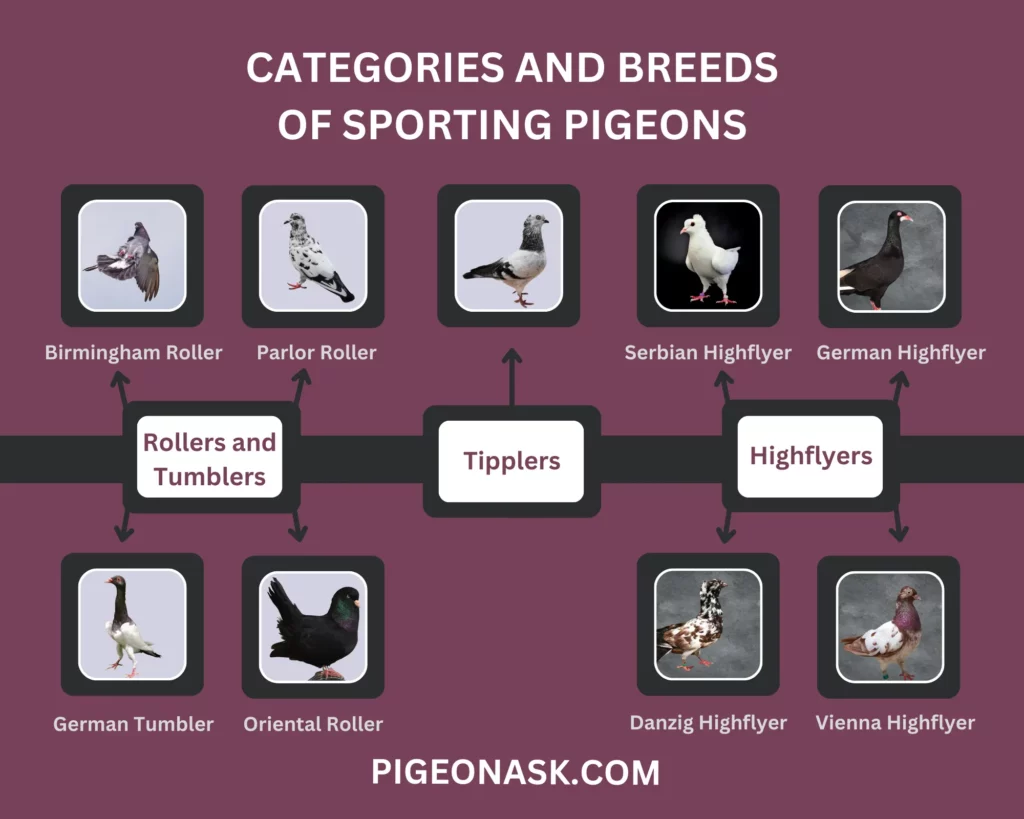
Rollers and Tumblers: Exemplary aerobatic skills.
- Birmingham Roller
- Parlor Roller
- German Tumbler
- Oriental Roller
Tipplers: Possess great endurance and stamina.
- Irish Blue
- Gordon Hughes
- Lovatt
Highflyers: Flies at high altitudes.
- Serbian Highflyer
- German Highflyer
- Danzig Highflyer
- Vienna Highflyer
It’s important to note that Rollers, Tumblers, and highflyers are parts of the Tumbler family. However, these are grouped separately because of their distinctive nature and ease of identification.
Among 64 listed Tumbler pigeons, 12 comprise Highflyers, 45 Tumblers, and 7 Rollers.
What Does a Flying/Sporting Pigeon Look Like?
Flying/Sporting pigeons include numerous breeds of many colors, and superficially, they all look different. However, there are some general identification signs where all overlap.
First, the color varies among breeds, as you already know. While most are found in shades of gray, white, black, and bluish-gray, strains with other colors are also present. The Serbian Highflyers, for example, come in a bluish-gray shade.
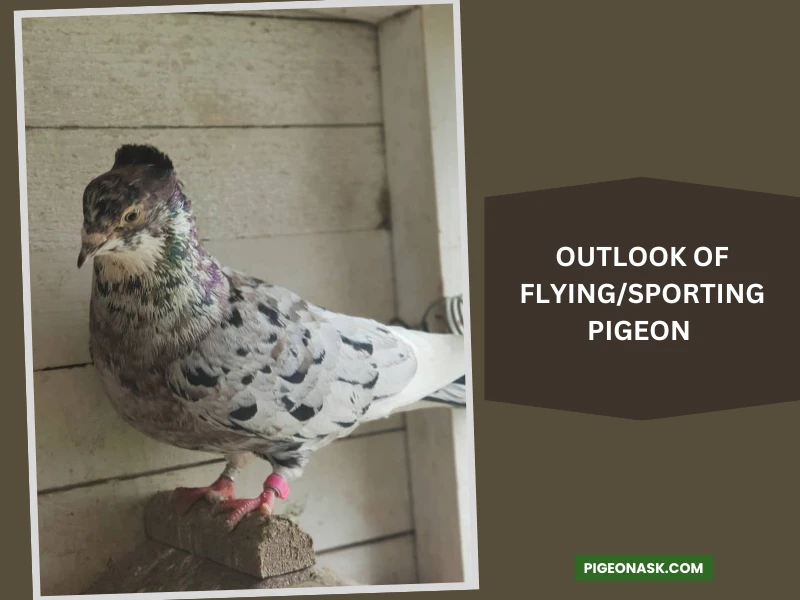
Flying pigeons are part of fancy pigeons. Therefore, like fancy pigeons, they have an elegant look with unique and peculiar wings, pupils, tails, and feathers.
German long-faced tumblers have, as the name suggests, a very long face and a slender body. Highflyers have smaller pupils.
Another identification sign is, of course, their in-flight acrobatics and other flying skills. So, if you see a pigeon swiftly rolling or flying high, you can almost always be sure it’s a Flying pigeon.
Their flying skills are very distinctive, necessarily distinguishing them from other strains.
The Physical Structure of Flying Pigeons
Sporting/Flying pigeons are generally small to medium in size, with a height and weight of 5-7 inches and around 250 grams, respectively. Their wings are a tad bigger than other pigeon breeds, spanning around 1.5 feet.
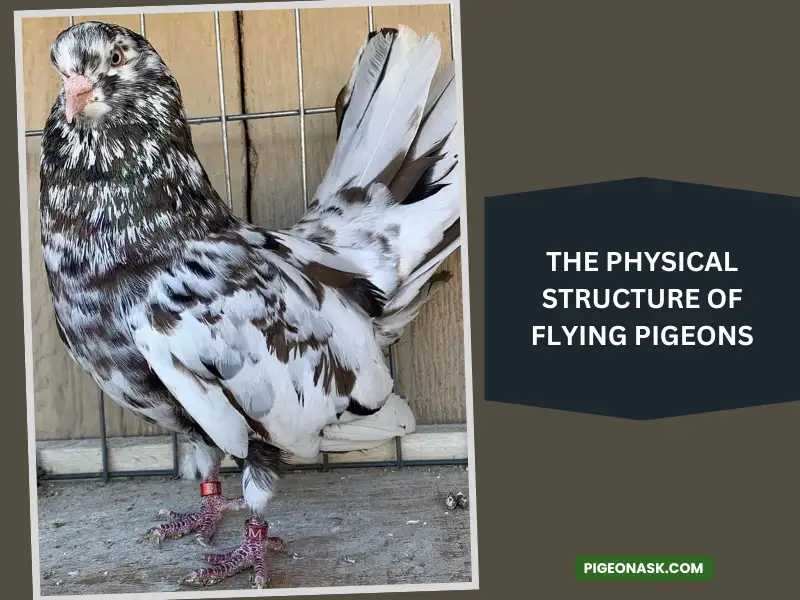
While the majority is small, some exceptions can be observed. Breeds like the English Long-Faced Tumbler, Serbian Highflyers, and others are a bit bigger, with a wingspan of more than 2 feet.
The short stature facilitates acrobatic skills. In addition, the small size gives them agility and speed.
The Popularity of Flying Pigeons
Pigeons have been providing men with utilities for a long time. In the beginning, these birds were a source of meat – the dominant use of this creature.
After discovering pigeons’ incredible qualities and intelligence, people started crossbreeding to achieve more specific characteristics depending on the intention of use and, in the process, gave birth to many fascinating breeds.
Fancy pigeons have always been in high demand. People from high society owned a considerable amount, as only they could afford to do so. In the Victorian era, the aristocrats kept fancy pigeons as pets.
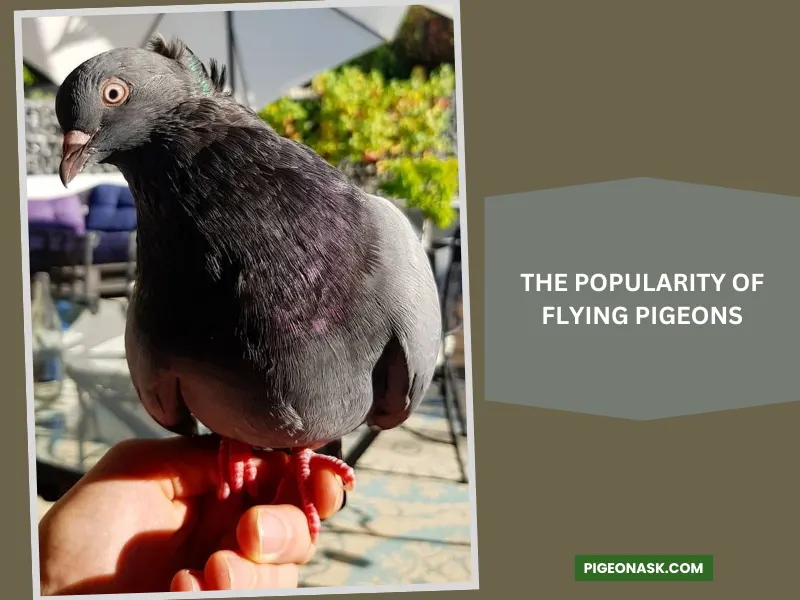
Emperor Akbar had a massive collection of pigeons, which comprised various breeds.
People in the past typically bought pigeons for their particularity and utilized them according to their specialties. For example, Homing pigeons were used for sending messages during wars, and Rollers were used for competitions.
However, nowadays, most people keep them as pets, for those pigeons give them joy. Flying pigeon breeds such as Rollers, Tumblers, and Highflyers are much desired and have been so since their origin.
Although their popularity declined in the early 20th century, they came back in style. People grew more laid back after the two world wars and started enjoying things of beauty that don’t necessarily have any materialistic gain.
Sound of Flying/Sporting Pigeons
Flying pigeons are gentle, and their noise reflects their nature. While flying and a quick takeoff, their wings make a loud whirring or whistling sound.
This particular noise is caused by a phenomenon called “Aeroelastic Flutter,” which causes the vibration on each narrow wing while flying.
These pigeons also make both gentle cooing sound and grunting sounds. When threatened, they show aggression and hiss at the threat.
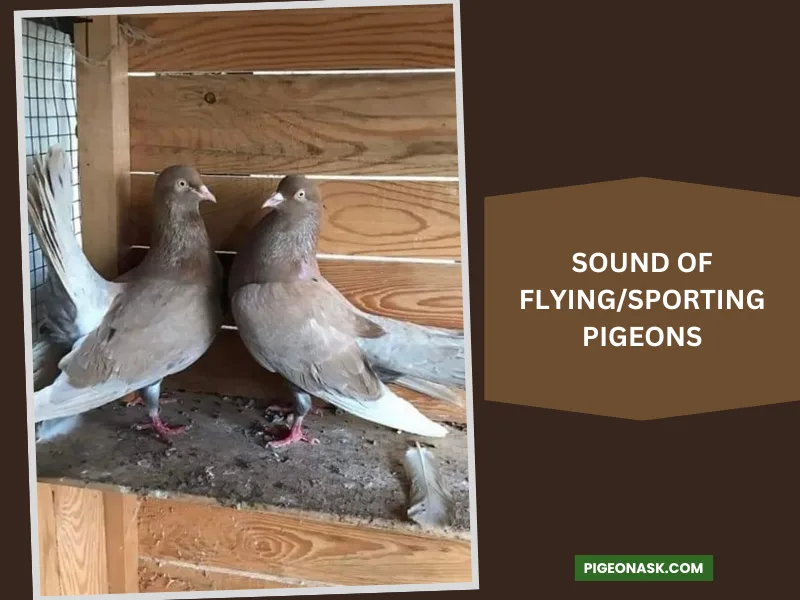
How Do They Sound When Mating? During the mating season, spring or fall, the male pigeons actively look for a female while making a prolonged cooing, which is generally their mating call.
The sound is usually loud, and they make it frequently. So, don’t be alarmed if your pigeons are being extra loud suddenly during the breeding season, as they are more likely looking for a partner for mating.
While mating, the male makes a cooing noise. Sound is essential as it helps them stay in sync and communicate with each other.
How Do Flying Pigeons Behave?
Flying pigeons behave according to their needs. They behave differently while playing, mating, or defending their territory. While flying pigeons are generally gentle, they can get rough when threatened.
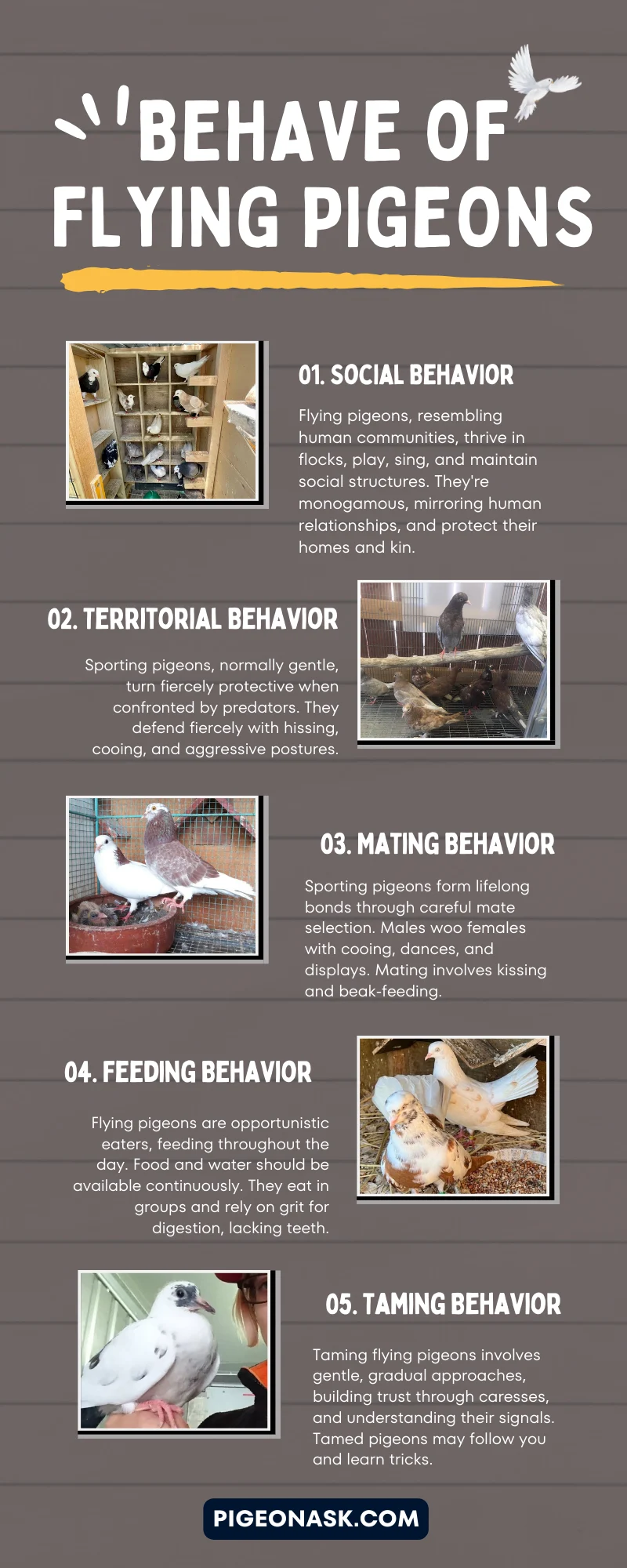
Social Behavior
Flying pigeons like to live in harmony with the members of their flocks. They are very much like humans. For example, they enjoy playing and goofing around and singing together.
Like humans, pigeons have a vertical social structure, which is comparatively flexible. Moreover, they are monogamous and typically mate for life, which also mimics human nature.
They are peaceful but tend to get violent when it comes to saving their homes and kin from uninvited visitors.
Territorial Behavior
Like any other birds, Flying/Sporting pigeons, especially males, get defensive and violent if attacked by a predator. They show no relent, and their calm nature instantly turns into violent while fighting off the outsider.
Although flying pigeons are bred in a safe space created by humans, every now and then, they do get attacked by crows, hawks, etc.
And when they do, the males shake off, start making loud hissing and cooing sounds, and get into fighting mode by stretching their heads forward and raising wings.
Mating Behavior
Flying pigeons mate for life, so the mate selection process is meticulous. During the mating season, male pigeons seek females. Upon encountering an eligible one, he approaches her while cooing and performing the mating dance and rituals.
Mating behaviors of the male include nodding his head, strutting, and spreading tail feathers to attract the female. If she is interested, she will nod and fly away if uninterested.
During mating, they coo and kiss each other by touching each other’s beaks. While kissing, the female inserts her beak inside the male’s and feeds him.
Feeding Behavior
Flying pigeons don’t have any particular time to eat; rather, they eat all around the day. They are opportunistic feeders, and their beaks are built in such a way that helps them pick up small foods.
You make sure to keep water and food available at all times, and the pigeons will get to them whenever they need them. Moreover, they tend to eat in groups, so ensure adequate feeds are available for them to grind on.
As pigeons don’t have teeth, like many birds, they swallow foods whole. These birds often eat small grits. Stones and gravel facilitate their digestion.
Taming Behavior
Flying pigeons are very docile and get tamed easily. It’s in their nature, and that’s how people were able to domesticate them in the first place many years ago. However, the taming process does require time and effort.
So, how do you tame your flying pigeons? To earn their trust, you need to gently approach them. So, don’t be rough and fast while handling and feeding your pigeons. You need to make them feel safe so they don’t perceive you as a threat.
Pigeons can understand affection, so you gently and slowly caress their neck, head, and body gently regularly. And leave them be if they show signs of discomfort.
They may loudly coo and grunt when they feel threatened. So look for those signs and handle them accordingly.
Once you tame your pigeons, they will greet you and gently coo. They will follow you around. Moreover, you can teach a tamed pigeon many tricks, such as rolling, tumbling, and playing dead.
What Do Flying Pigeons Eat?
Like other domestic pigeons, Flying pigeons eat almost anything they are offered. You can give your pigeons any food available in your home. Having said that, there are some special foods flying pigeons tend to enjoy. Like –
- Cheese
- Sprouted seeds
- A mixture of breadcrumbs and eggs
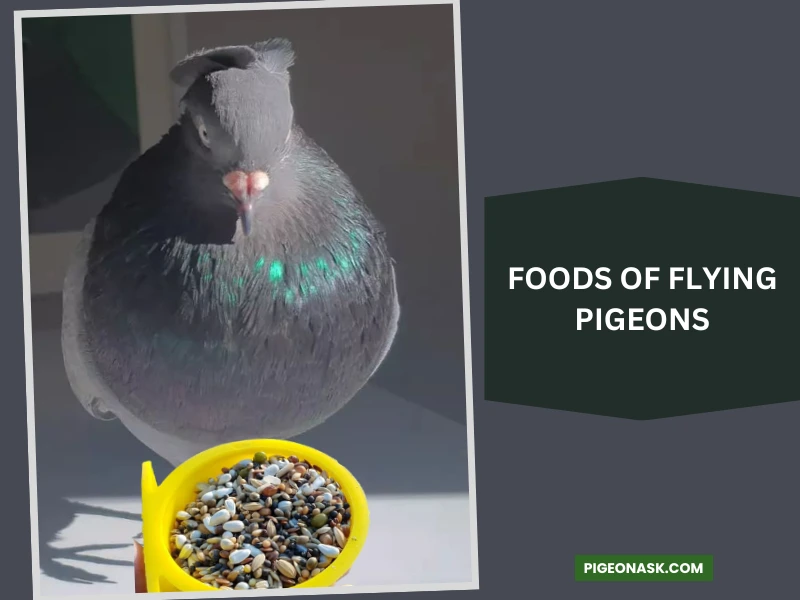
Many birds ingest gravel and small stones, known as grits, to grind food in their gizzard, a muscular part of their stomach where food is broken down. Pigeons are grit-eating birds.
Natural Foods of Flying Pigeons
Flying pigeons’ natural diet consists of –
- Insects and bugs
- Fruits and vegetables
- Seeds and grains
Commercial Foods
Along with giving natural foods to your flying pigeons, you can provide special pigeon feeds, which you can find at stores.
- Pigeon feed (a mixture of seeds and grains)
- Brewers’ yeast
- Sorghum, rice, and flax
How Long Do Flying Pigeons Live?
Pigeons usually don’t live long, and this is especially true for the wild ones. The average lifespan of a wild pigeon is 3-5 years.
However, with proper care and modern medicine, domestic pigeons (flying, utility, homing, etc.) can live up to 15 years. The longest living record is 24 years.
Geographic Distribution of Flying/Sport Pigeons Across the World
Flying pigeons are still adored and celebrated in many parts of the world. Let’s take a look at which flying/sporting pigeons are thriving in which regions of the world.

1. Canada
Pigeon racing has been seeing a surge in popularity in Canada, and it’s not surprising. New clubs related to fancy pigeon breeding and racing are constantly popping up everywhere.
The Canadian Racing Pigeon Union (CRPU) ensures that the pigeon breeding culture is thriving in the country. Cultivation and preservation of many prominent breeds are still continued by the breeders.
2. The United States
Pigeon racing and flight shows were popularized in the US back in 1875, and the trend is still going strong in many regions of the country.
And leading groups like the American Pigeon Racing Union (ARPU) are working to keep it this way in the far future.
According to a study, an impressive number of 15000 lofts are registered across the US. Some cities and states where pigeon racing is highly popular now are New York, New Jersey, Coney Island, etc.
3. Asia
Many countries in Asia have a blooming culture of pigeon cultivation for aerial shows. Countries like India, China, Pakistan, Bangladesh, Indonesia, Japan, etc. are pioneering the growth of pigeon breeding and show scopes.
Karachi, Lahore, and Peshawar are famous for breeding good-quality racing and high-flying pigeons.
In Bangladesh, there are thousands of registered pigeon breeders and fanciers who are constantly breeding high-quality roller and tumbler pigeons.
Taiwan is the biggest enthusiast country of pigeon racing. It’s assumed that there are slightly below three million birds in the city, and this city arranges more racing events than any other country in the world.
4. Europe
Although Europe is the origin of the specialized pigeon breeding trend, the current condition of pigeon breeding and shows is quite subpar compared to Asia or the US.
Belgium, Romania, and Turkey are some of the few countries that still enjoy the culture and work for its preservation. Interest in pigeon racing is steadily falling in various countries, including the United Kingdom.
5. Australia
Interest in pigeon breeding and racing is declining in Australia as well. This is because the dedicated club members are mostly senior citizens, and many have died off.
The young are not finding enough interest in the matter, mostly because of the high cost of feed and pigeon-caring materials in the continent.
6. Africa
In the continent of Africa, South Africa is the most interested country in flying/sporting pigeon breeding. The country hosts one of the most lucrative one-loft races in the entire world, with incredible prizes for the contenders.
Four thousand three hundred different best-in-their-business pigeons from across the world arrive in South Africa with their trainers to take part in this epic race.
Due to this race, South Africa has become a welcoming hub for fancy pigeon breeders all over the world.
The Maintenance Costs of Flying Pigeons
The maintenance costs of flying pigeons are relatively lower. They are easy to care for and aren’t as picky as other domestic birds. Let’s give you an overview –
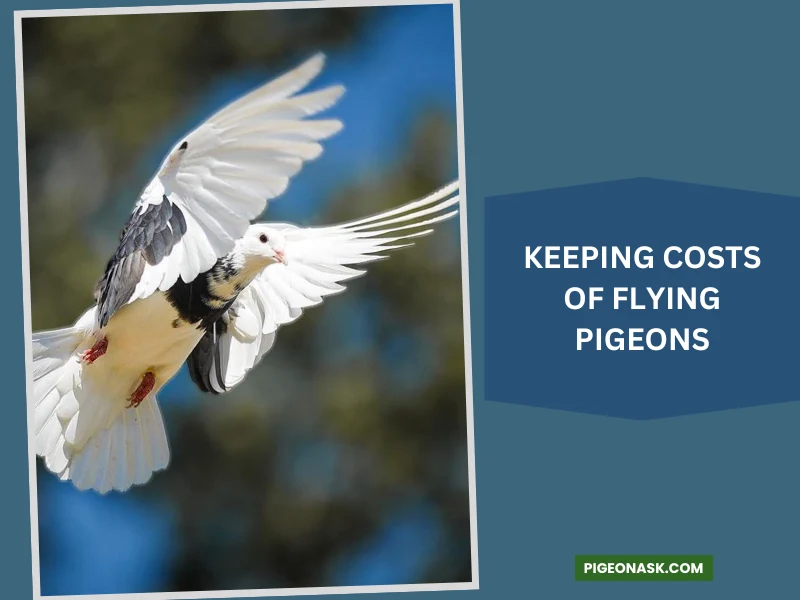
Setting up Home
Basic housing costs around 100 dollars; in most cases, the expenditure is even lower. You buy wood from local vendors and set up the pigeon holes yourself, keeping the cost under 100 bucks.
That said, the price will vary based on your desired habitat quality.
Healthcare
Flying pigeons are not as sickly as other birds and animals. If you initially give all the vaccines, the pigeons are unlikely to fall sick. So, you can relax in terms of medical expenditure.
The initial cost includes the purchase of vaccines and sanitary products to disinfect the habitat. And later on, you may have to give them vitamin supplements if required and take them to veterinarians if they fall sick.
Feeds
You don’t have to spend as much on them. They are renowned for being not picky when it comes to food. This is why raising pigeons is popular among financially “less” capable people, as the pigeon business takes less capital.
To many people, especially from South Asia, selling pigeons is a source of livelihood.
Flying pigeons eat anything found, from vegetables to fruits and seeds to grains.
From time to time, you may need to buy store-bought foods. However, these are usually affordable.
Home Maintenance
You have to check the breeding ground and pigeonholes to see whether they are up to the standard and require fixing or modifications.
Similar Birds of Flying Pigeons
Flying pigeons are a small portion of domesticated pigeons. There are several other types of both domestic and wild pigeons.
The main 3 types of domestic pigeons are Flying/Sporting, Utility, and many other Fancy pigeon breeds, such as Homing/Racing, Exhibition breeds, etc. And let’s not forget about pigeons’ closest family members, Doves.
- Homing/Racing Pigeons: English Carriers, Chinese Owls, Oriental Frills, etc.
- Utility Pigeons: King pigeons, Giant Runt, French Mondain, etc.
- Exhibition: English Carriers, Indian Fantails, Thai Fantail, and some other fantails.
- Doves: Mourning Dove, European Turtle, Zebra Dove, etc.
- Wild Pigeons: Hill Pigeons, Snow Pigeons, Common Woods, Trocaz Pigeons, etc.
Breeding and Caring Tips for Flying/Sporting Pigeons
Here are some tips that should help if you wish to breed pigeons yourselves and care for them.
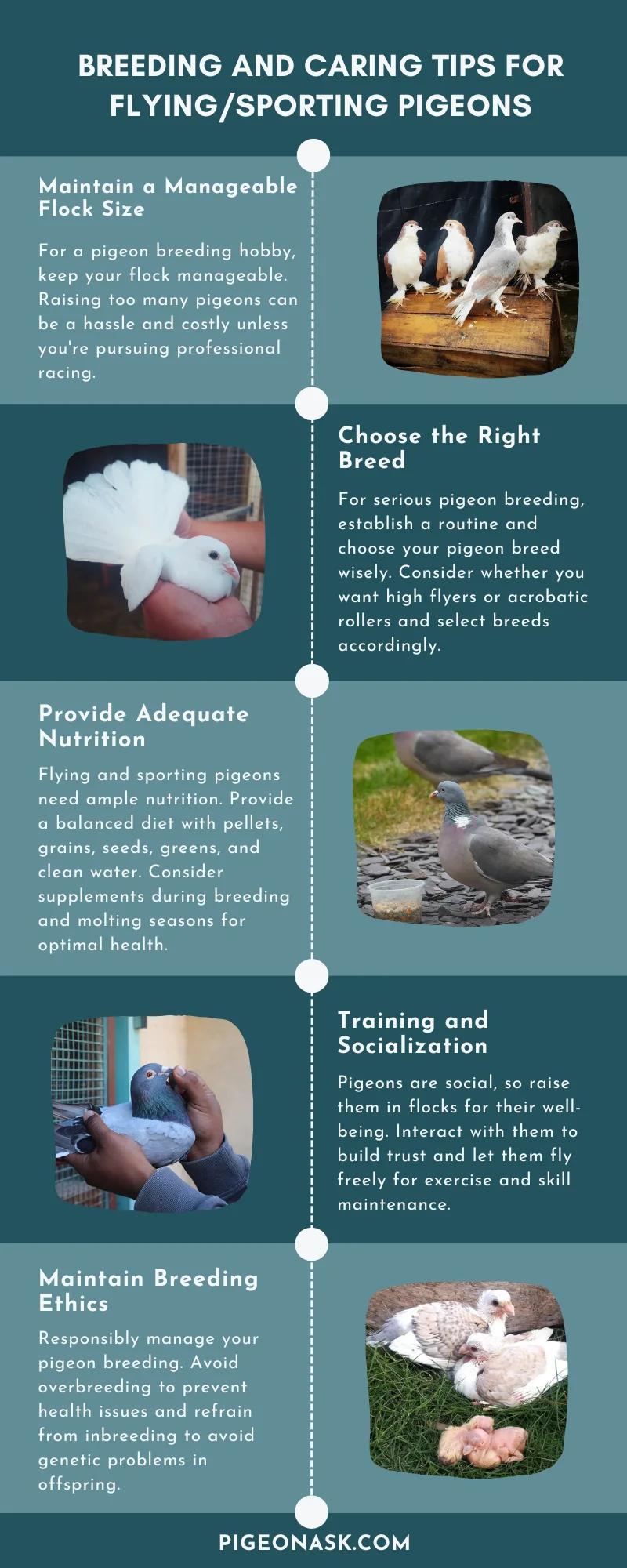
Maintain a Manageable Flock Size
If you wish to breed your Flying/Sporting pigeons and take care of pigeons as a hobby, make sure to keep the group size manageable. Remember that raising more pigeons means more hassle as well as increased cost.
So, unless you’re interested in participating in professional races, don’t turn your pigeon breeding hobby into a chore.
Choose the Right Breed
If you wish to seriously get into breeding flying/sporting pigeons, you’ll need to fix your regime and choose the right pigeon breed.
Do you want a high-flying breed or one with exceptional aerial acrobatics like rolling? Assess your requirements and select the best breeds suitable for your purpose.
Provide Adequate Nutrition
Flying/sporting pigeons work harder and consequently require more nutrition. Make sure you offer a regular and balanced diet to your pigeons that consists of high-quality pigeon pellets, grains, seeds, and fresh greens.
Also, ensure that your pigeons can always access clean, fresh water. They require more nutrition during breeding and molting seasons, so consider adding supplements to their diet.
Training and Socialization
Pigeons are social birds, so don’t try to raise them alone. Also, spend time interacting with your pigeons. This will build their trust and strengthen the bond between you and your birds.
Allow them to fly freely in flocks, as they require regular exercise to maintain their fitness and skills.
Maintain Breeding Ethics
Be responsible and avoid overbreeding your pigeons. Overbreeding can lead to severe health issues. Also, avoid inbreeding. Inbreeding can lead to pigeons born with genetic health problems.
Conclusion
Flying pigeons have been a part of men for thousands of years. These are still popular and are kept as pets, show birds, and commercial products. There are 3 subgroups of flying pigeons – rollers and tumblers, tipplers, and highflyers.
Rollers and tumblers do flips in the air, while tipplers can fly for a long time, and highflyers can reach a high altitude. Flying pigeons are easy to care for and therefore, take minimal effort. Their foods are cheap, and the habitats are cheap to build.
Anyway, that’s all for the article; we sincerely hope you found the answers you were looking for. We would appreciate it dearly if you could share this content and stay connected with us on Facebook, Twitter, and Pinterest. Ciao!
References:
- https://www.researchgate.net/publication/333682498_Worlds_highflyer_tumbler_and_roller_pigeons
- https://www.mentalfloss.com/article/54844/history-pigeon
- https://a-z-animals.com/blog/pigeon-lifespan-how-long-do-pigeons-live/
